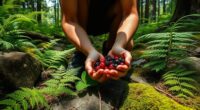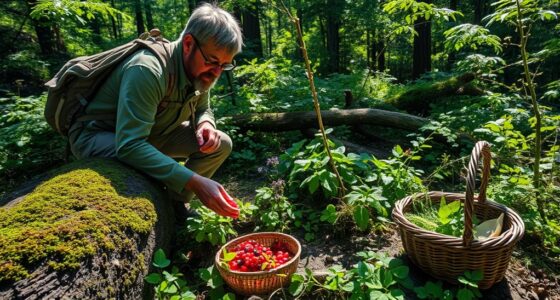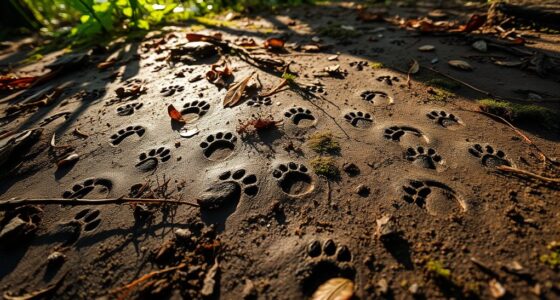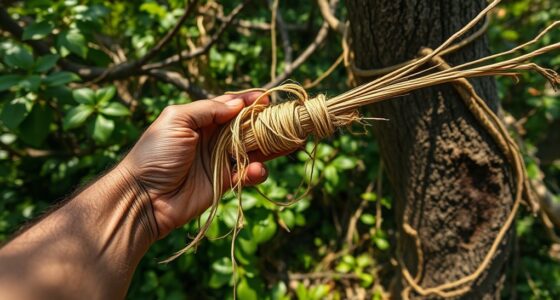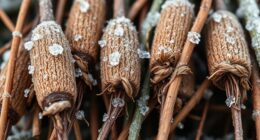In a post-apocalyptic scenario, you’ll rely on wild edible plants like dandelions, chickweed, and stinging nettle, which are nutritious and easy to identify. You’ll need to learn mushroom safety tips to avoid poisonous varieties and pick ripe berries such as blueberries or raspberries for quick energy. Preserving your harvest with drying or freezing helps guarantee long-term food security. Mastering sustainable foraging and community sharing boosts your chances for survival—explore more to become fully prepared.
Key Takeaways
- Identify and harvest native edible plants like dandelions, chickweed, and cattails, ensuring proper identification to avoid toxins.
- Safely forage wild mushrooms by learning species-specific signs and avoiding poisonous lookalikes.
- Preserve gathered foods through drying, freezing, or pickling to ensure long-term availability.
- Practice sustainable foraging by avoiding overharvesting and respecting ecosystems to maintain food sources.
- Collaborate with community networks and food banks to access reliable supplies and coordinate resource sharing.
Identifying and Harvesting Common Edible Plants

To successfully forage in disaster scenarios, you need to learn how to identify and harvest common edible plants safely. Recognize dandelions, which grow in lawns and fields, and harvest their leaves, flowers, or roots when they’re at their peak.
In tropical regions, wild spinach like Gnetum offers nutritious, spinach-like leaves. Konjac produces starchy roots perfect for food when correctly prepared. Cattails, identified by their distinctive flower spikes, provide edible roots and shoots, especially in wetlands.
Burdock, with its large leaves and roots, is useful for teas and soups. Focus on harvesting plants at their nutritional peak, using knives or scissors to minimize damage. Only take what you need, clean and dry plants before eating, and be resourceful with makeshift tools to ensure safe, sustainable foraging. Additionally, understanding water safety is crucial when collecting aquatic plants to avoid contamination or hazards in wetland environments.
Wild Mushrooms: Safety and Selection Tips
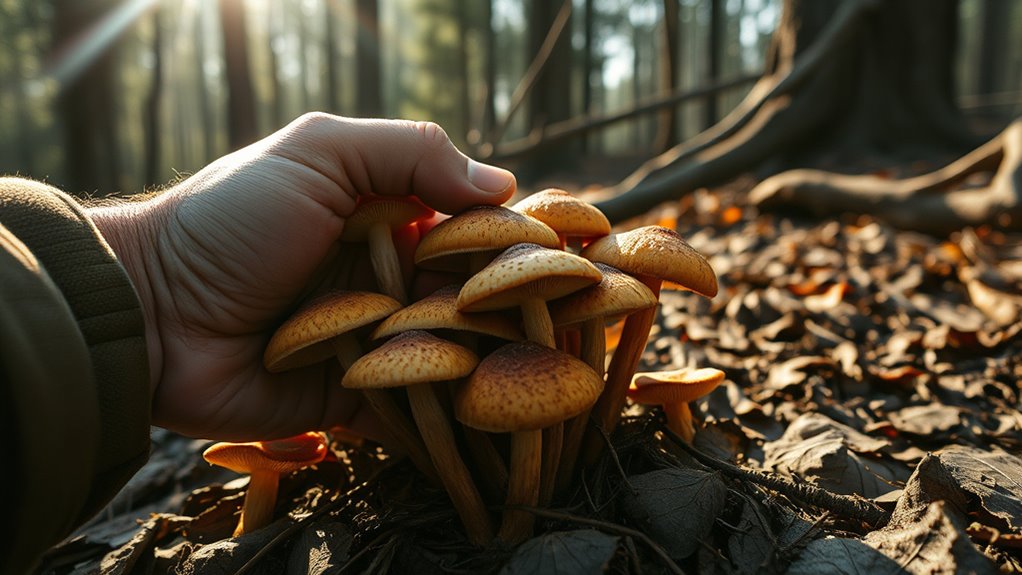
While harvesting edible plants is a key skill in disaster scenarios, wild mushrooms can be a valuable addition to your foraging repertoire—if you know how to identify them safely. Many mushrooms are nutritious, packed with protein, potassium, and immune-boosting compounds.
They thrive in various environments, including low-light areas like underground shelters, making them accessible even in adverse conditions. However, many wild species are poisonous, so accurate identification is essential to avoid poisoning. Recognizing edible mushroom species and understanding their typical habitats and growth seasons can significantly reduce risks associated with foraging. Learning about mushroom identification techniques can further enhance safety during foraging. Additionally, understanding cost behavior analysis can help you better allocate resources for your survival efforts in such scenarios.
Pay attention to environmental cues, like moisture levels, which influence mushroom availability. Understanding natural signs or warnings can sometimes provide insight into safe foraging practices and potential hazards.
Berries and Fruits: Gathering Nutritious Snacks
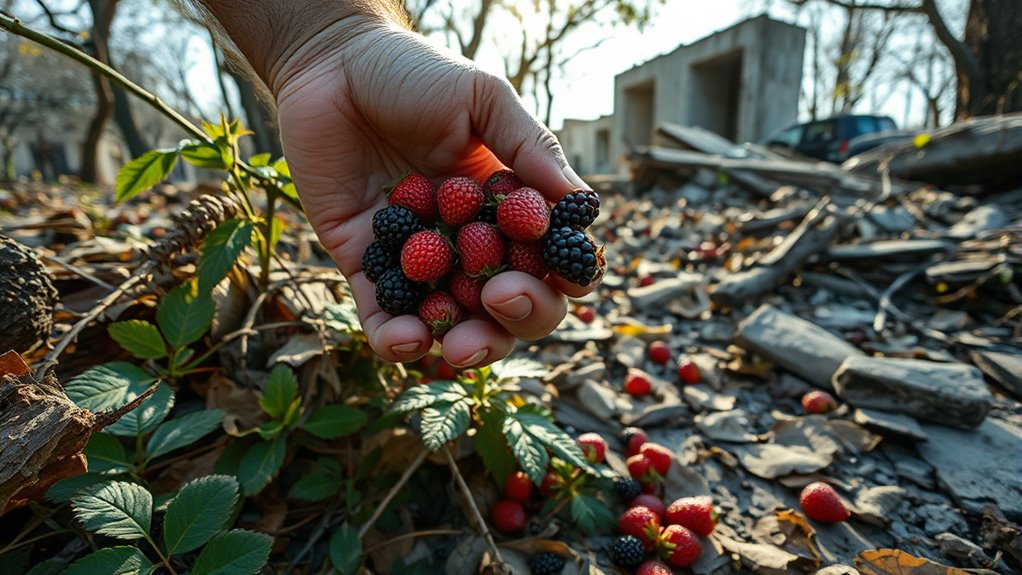
Ever wondered how to gather nutritious snacks in a disaster scenario? Berries and fruits are excellent sources of quick energy, packed with carbohydrates and essential vitamins like vitamin C and potassium. They’re low in calories but rich in nutrients, making them a smart choice for sustained survival.
Look for wild berries such as blueberries, raspberries, elderberries, or rose hips in wooded areas, riverbanks, and abandoned farms. Always identify plants carefully to avoid poisonous lookalikes. Wash fruits thoroughly before eating to remove dirt and bacteria, and pick only ripe specimens for maximum nutrition. Additionally, choosing proper location and installation considerations can help you access these foraging sites more safely and efficiently when exploring remote areas. Knowing how to recognize edible versus poisonous plants is crucial to avoid dangerous mistakes.
During warmer months, these wild treasures become abundant, providing crucial sustenance. Dried or preserved fruits can be stored long-term, helping you maintain a steady supply of nutritious snacks when fresh options are scarce. Understanding foraging safety is essential to avoid dangerous plants and ensure a successful foraging experience.
Edible Herbs and Greens for Flavor and Nutrition

Looking for ways to add flavor and nutrition to your foraged meals? Edible herbs and greens are excellent options. Dandelions provide protein, calcium, iron, and vitamins A and C—great in salads, wines, or desserts. They are also resilient and can grow in a variety of environments, making them a reliable food source. Incorporating plant biodiversity can help ensure a steady supply of these nutritious greens during challenging times.
Enhance your foraged meals with nutritious, flavorful herbs like dandelions, chickweed, and plantain leaves.
Chickweed offers vitamins, helps with inflammation, and adds a mild flavor to sandwiches and salads. Its quick growth makes it easy to harvest regularly.
Self heal is packed with antioxidants and can be enjoyed raw or as tea. Its traditional medicinal uses highlight its importance in plant-based remedies during times when modern medicine may not be available.
Red clover supplies protein, antioxidants, and B vitamins, perfect for salads or soups but should be eaten in moderation. Proper preparation, like drying or freezing, helps preserve these herbs for ongoing use.
Plantain leaves are versatile: young leaves for salads, older ones for soups. They are often overlooked but are highly nutritious and easy to identify in the wild.
Wild greens like mustard greens, stinging nettle, thistles, kale, and lettuce boost your nutrition while enhancing flavor. Proper identification and preparation are crucial, especially for stinging nettle, which requires careful handling to avoid skin irritation.
Seasonal Foraging Strategies for Reliable Food Sources
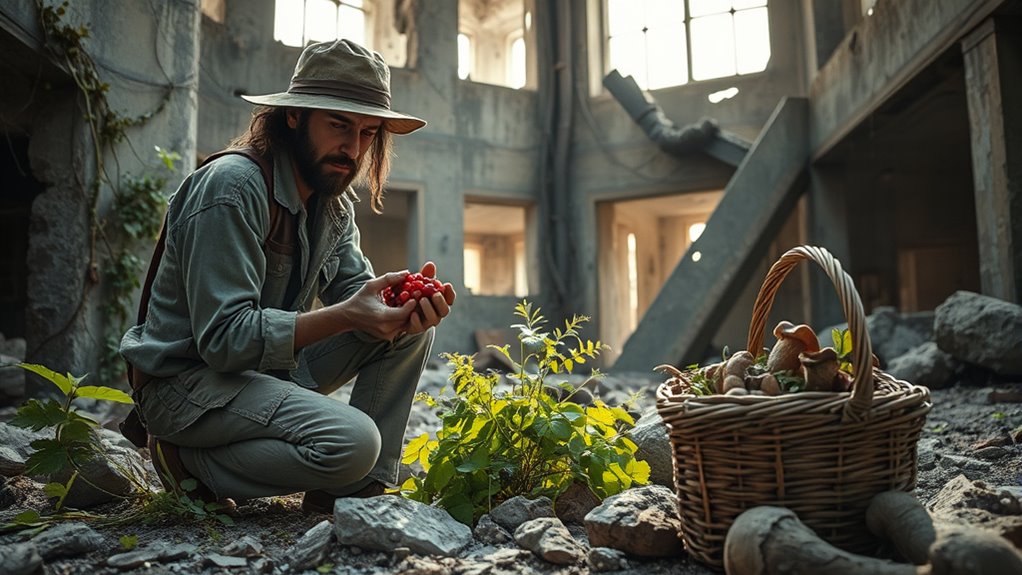
By understanding how plant availability shifts with the seasons, you can develop effective foraging strategies that guarantee a steady food supply.
In spring, focus on tender greens, shoots, and early bulbs to replenish vitamins after winter.
Summer offers ripe fruits, berries, seeds, and nuts, providing essential carbs and fats for energy.
Fall is key for harvesting nuts, root vegetables, and late-season fruits, storing calories for leaner months.
During winter, target hardy species like bark, evergreen needles, roots, and animal sources.
Prioritize plants with high caloric or protein content year-round.
Adapt your practices based on climate, seeking underground parts in cold weather or drought-resistant species during heat.
Proper timing and sustainable harvesting ensure a reliable, nutritious food flow throughout the year.
Preparing and Preserving Wild Edibles

Preparing and preserving wild edibles is essential for maximizing their safety, nutritional value, and shelf life during a disaster. First, sort and clean your foraged items thoroughly to remove dirt, insects, and contaminants. Always identify and remove toxic parts to prevent poisoning or allergic reactions. Use proper cooking methods like boiling, steaming, or frying to make plants safer and easier to digest. Ensuring correct tire pressure when transporting edible supplies can help prevent damage and spoilage during storage or carrying. When testing unknown plants, perform basic toxicity tests, such as the Universal Edibility Test. To preserve wild edibles long-term, dry herbs and leaves, can fruits and vegetables, or freeze-dry to retain nutrients. You can also pickle foods or infuse oils with edible plants for future use. Understanding filtration technology and appropriate preservation methods can help maintain the safety and nutritional quality of your wild edibles. Incorporating vendor reliability assessments into your planning can ensure access to safe and dependable supplies during prolonged disaster scenarios. Proper preparation and preservation guarantee your wild edibles remain safe and nutritious when needed most.
Sustainable Foraging and Cultivation Practices
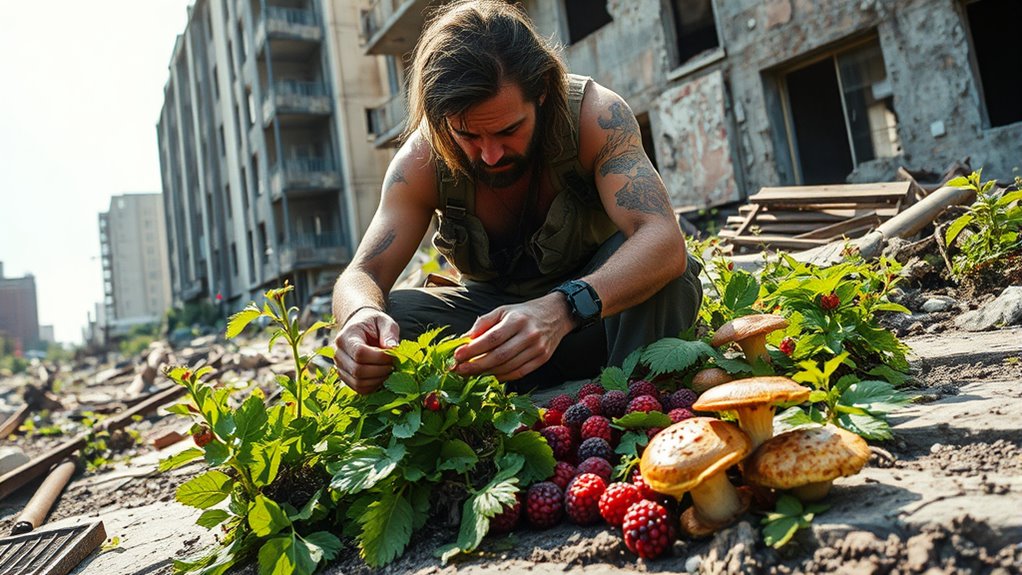
Understanding sustainable foraging and cultivation practices is essential for guaranteeing long-term access to wild and cultivated food sources, especially during disasters. By diversifying your food sources, you reduce dependence on a single plant, increasing survival chances. Knowing how to identify edible plants like dandelions, thistles, and stinging nettle ensures you harvest safely. Remember, seasonal changes affect plant availability; roots are best in fall and winter, greens in spring. Avoid plants growing near pollutants to prevent contamination. Practicing conservation, such as avoiding overharvesting, helps preserve ecosystems and maintains long-term food supplies. Cultivating your own garden using permaculture principles maximizes land use and resource efficiency. Employing proper growing methods, such as organic cultivation and sustainable watering techniques, further supports resilient food systems. Incorporating spiritual awareness into your foraging practices can enhance your connection with nature and promote mindful harvesting. Developing community networks can also enhance resource sharing and collective resilience during crises. Using available materials for tools and infrastructure supports sustainability. Additionally, understanding the importance of crop rotation can help maintain soil health and prevent depletion of nutrients. Engaging in soil regeneration practices can further enhance land productivity and resilience. Together, these practices foster resilience and secure food sources during challenging times.
Building Community Networks for Food Security
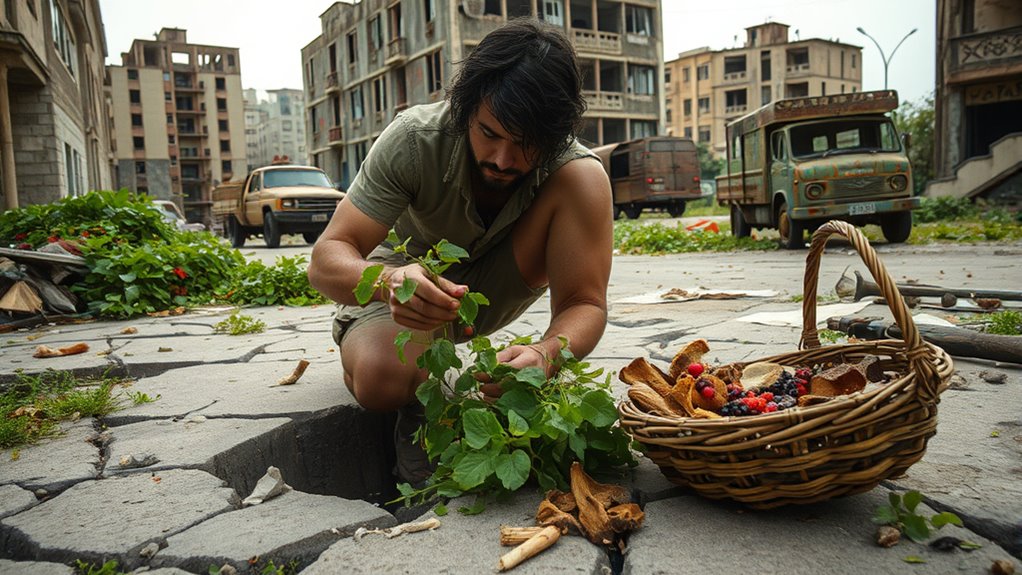
Building strong community networks enhances food security, especially during disasters when access to reliable food sources can be disrupted. Food banks play an essential role by providing immediate assistance and adapting to local needs, making certain vulnerable populations get support.
Coordinating with relief organizations creates an all-encompassing response, maximizing resources and response times. Engaging local communities makes them more resilient, enabling quick action when crises strike.
Incorporating food banks into emergency management plans guarantees timely aid. Using existing infrastructure like farmers markets and community-based programs boosts distribution and increases access to nutritious food.
Partnering with local farms ensures fresh produce availability. Implementing local building codes and permits can streamline the renovation process and ensure safety standards are met. These strategies help communities adapt, improve disaster resilience, and foster long-term food security even amid chaos.
Frequently Asked Questions
How Can I Differentiate Between Edible and Toxic Wild Plants?
To differentiate edible from toxic wild plants, start by examining leaves, flowers, and fruit shapes. Look for distinctive features, like seed patterns or growth habits, and use reliable field guides.
Be cautious of plants with similar appearances, especially those from known toxic families. Avoid unfamiliar berries or plants with white berries, and observe animal eating habits if possible.
Always double-check with trusted sources before consuming any wild plant.
What Tools Are Best for Efficient Foraging and Preservation?
You might find it surprising, but the right tools make all the difference in foraging and preserving food efficiently. An axe helps you access fruits high in trees, while a sickle streamlines harvesting grains.
Fishing gear ensures you catch enough fish, and traps catch small game effortlessly.
For preservation, smoking, curing, and dehydrating extend your supplies. Combining these tools with resourcefulness boosts your chances of survival in any scenario.
When Is the Optimal Season for Harvesting Specific Wild Foods?
You want to know the best season for harvesting wild foods. Spring is ideal for wild garlic, dandelion greens, and early herbs.
Summer offers berries, mushrooms, and greens, while autumn is perfect for roots, acorns, and rose hips.
Winter allows for gathering roots, conifer needles, and evergreen leaves.
Timing is key—harvest at peak ripeness to maximize flavor and nutrition, ensuring your foraged food sustains you effectively.
How Do I Safely Identify Edible Mushrooms in the Wild?
To safely identify edible mushrooms in the wild, start by examining their visual features, like shape, color, and size. Use reliable guides or online resources to match these traits.
Look for distinctive textures and patterns, such as gills or tubes.
Always double-check with multiple sources and avoid mushrooms growing near pollution.
When in doubt, don’t take the risk—consult experts or community knowledge to prevent poisoning.
What Are Sustainable Practices for Long-Term Wild Food Gathering?
Imagine your foraging journey as tending a fragile garden; you need patience and care. Focus on abundant, resilient plants and respect local laws.
Learn proper identification to avoid toxic species, harvest minimally, and use gentle tools. Think of yourself as a steward, balancing nature’s needs with your own.
Share knowledge, seek permission, and watch the ecosystem thrive. Your careful practice guarantees a sustainable bounty for generations to come.
Conclusion
By learning to identify edible plants, harvest wild mushrooms safely, gather nutritious berries, and preserve your finds, you’re building resilience, ensuring survival, and fostering sustainability. Embrace seasonal strategies, practice sustainable foraging, and connect with your community to strengthen food security. Stay curious, stay cautious, and stay committed—because in a disaster scenario, your knowledge, your preparation, and your cooperation will be your greatest assets. Together, you can turn foraging into an essential skill for survival.


